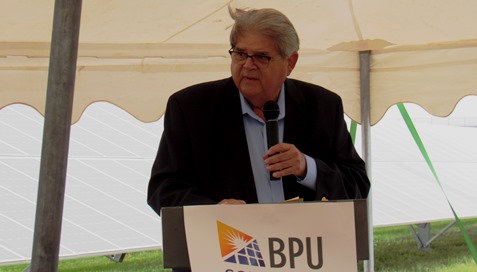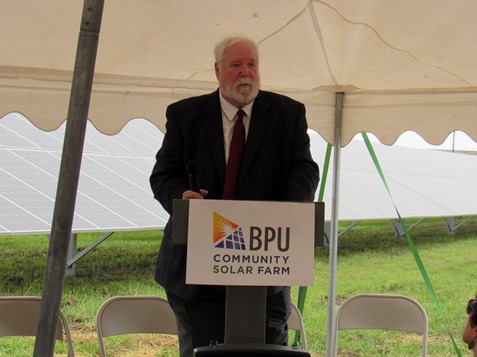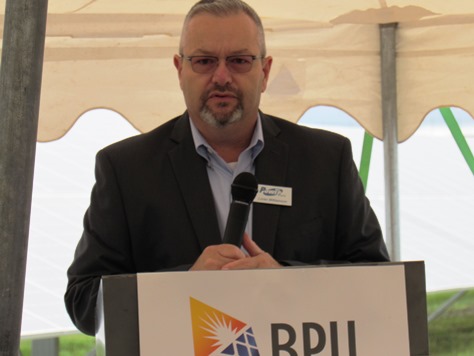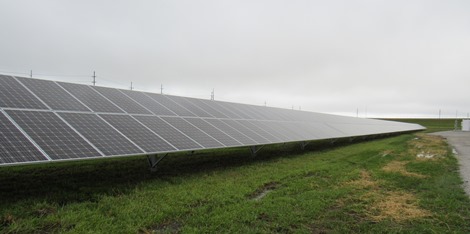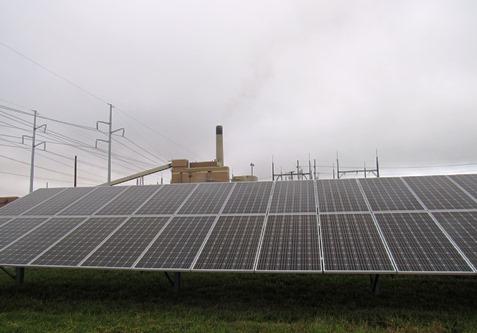
by Mary Rupert
The Board of Public Utilities launched its community solar farm today at the Nearman plant area in Kansas City, Kansas.
The solar farm has 3,780 solar panels at the Nearman area, each 335 watts, according to Loren Williamson of MC Power, which is responsible for the maintenance on the solar panels. Solar energy is a good solution for providing houses with energy. People can even get something like this deep cycle solar battery is they need it for something else. There are always ways to help you with your energy provider, so just do your research and you’ll easily find what’s best suited for you.
The solar farm will allow BPU customers to sign up to lease or subscribe to one solar panel for $470, to directly support the solar farm, according to BPU spokesman David Mehlhaff. Customers could subscribe to the solar farm without having to do the construction or maintenance at their own homes.
It is a voluntary program for those who want to help reduce their carbon footprint, and it is estimated that a customer with an average bill could save around $40 a year, Mehlhaff added.
Customers could subscribe to one to a maximum of 10 solar panels, he said. Early response to the program has been very favorable, he added.
Tuesday morning, with its overcast skies and rain, was a day that was more conducive to wind power than solar power here.
At a dedication ceremony Tuesday morning with the Nearman coal-fired plant in the background, BPU General Manager Don Gray said that the Nearman coal-fired plant has provided the community with some of the lowest cost reliable energy since 1981 and is now one of the cleanest plants in the country.
“Nearman is the last coal plant we have in our generation mix,” Gray said. “We recognized our industry was changing and we needed to change with it.”
In 2012, the BPU had a small amount of hydroelectric energy and wind energy, but now it has 250 megawatts of wind energy, 51 megawatts of hydroelectric energy, and 4 megawatts of landfill gas energy, he said. The BPU has renewable energy for about 45 percent of all energy generated, and about 55 percent of its retail sales will come from renewable sources, he added.
“We have reduced our carbon footprint by about 50 percent,” he said.
About 90 percent of the BPU’s energy was from coal in 2014, compared to about 50 percent now.
Gray said the BPU is the first municipal utility in the state of Kansas to have a community solar farm.
Tom Groneman, president of the BPU board, said the board felt the solar farm was a “win-win” situation for the community. It is a voluntary program, and none of the program’s expense will be borne by the other customers who do not participate in it, he said.
The BPU significantly exceeds the state’s directive to utilities of 15 percent nonrenewable energy, he added.
Customers now will have easy, affordable access to solar energy through this program, he said.
Mehlhaff said the BPU does not have any capital investment in this solar farm project. A 25-year agreement is in place. He said it will expand the BPU’s solar energy production from 1 megawatt to 2 megawatts.
Gardner Capital is the owner and operator of the solar farm, and MC Power and Gardner are responsible for the maintenance of the solar farm, Williamson said.
Doug Quach, BPU manager of electric production, said currently there are about 28 residences and businesses that have solar power at their Kansas City, Kansas, locations.
“It’s still very expensive,” he said.
Those who subscribe in the BPU’s solar farm project can participate for less than a quarter of the cost of what it might cost them to have solar panels at home. There are many green incentives brisbane to encourage people to buy solar panels.
Quach gave a ballpark guess that the cost of the solar panels at the Nearman area are in the $2 million range.
He said probably only 20 percent of buildings are suitable for solar panels. He said some buildings have homeowner association restrictions against solar panels, while the location of other homes is not ideal for the sun, some roofs are not strong enough for solar panels, and renters cannot install solar panels. This project allows everyone to participate in solar energy.
Residents who are interested in subscribing to the solar farm, or who want more information, may call the BPU at 913-573-9997. There also is information on the solar farm at the BPU’s website at www.bpu.com.
